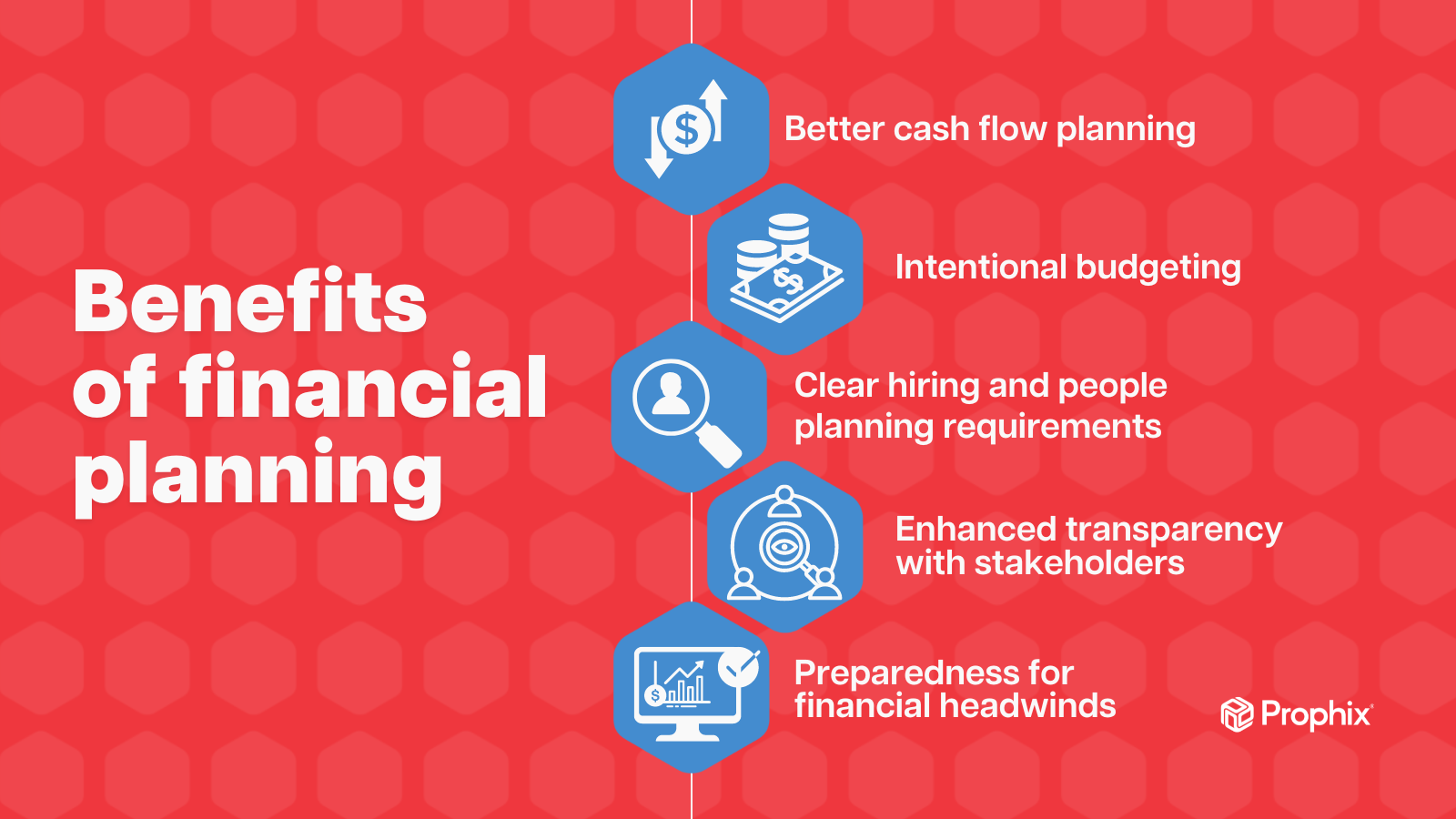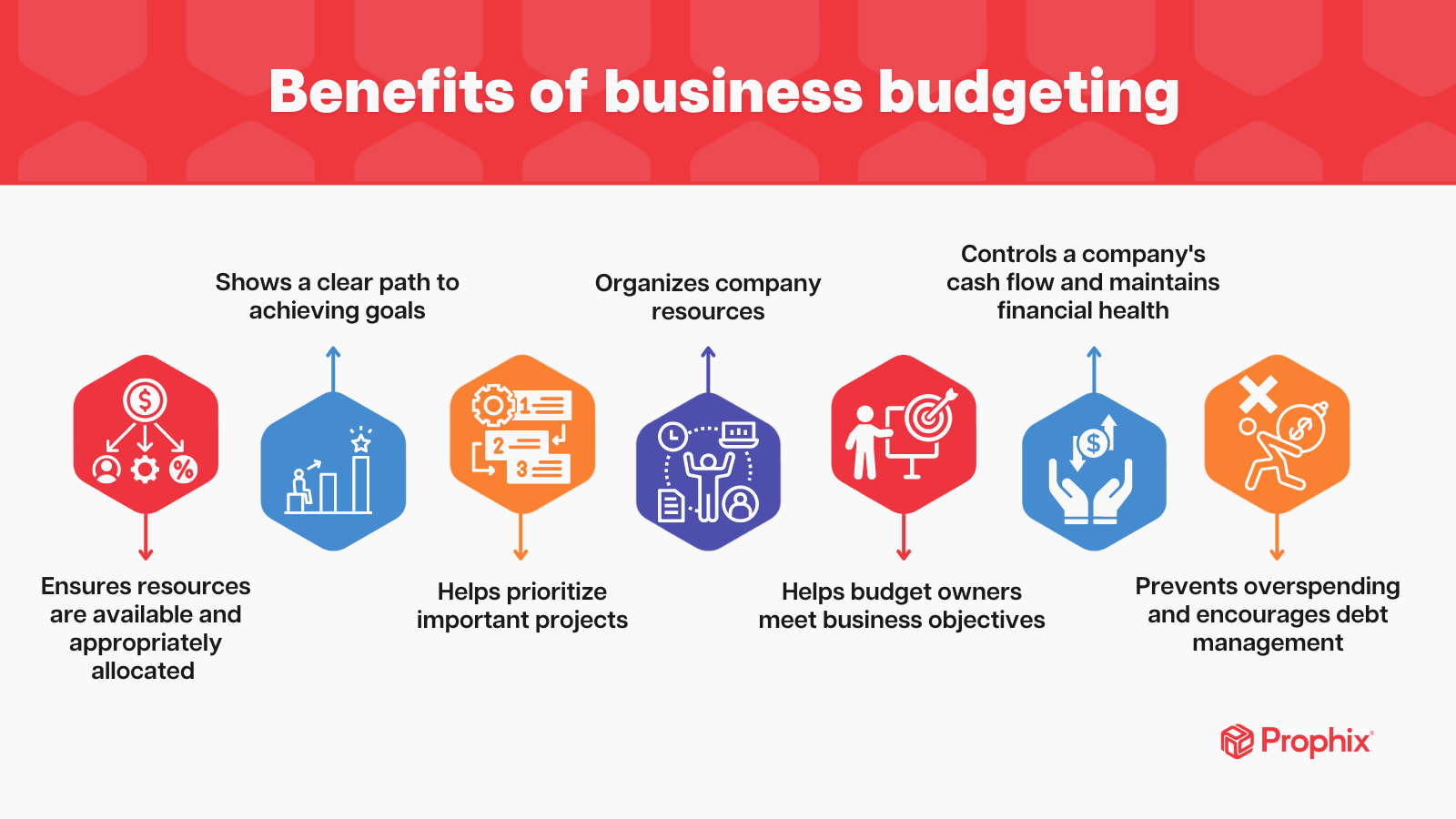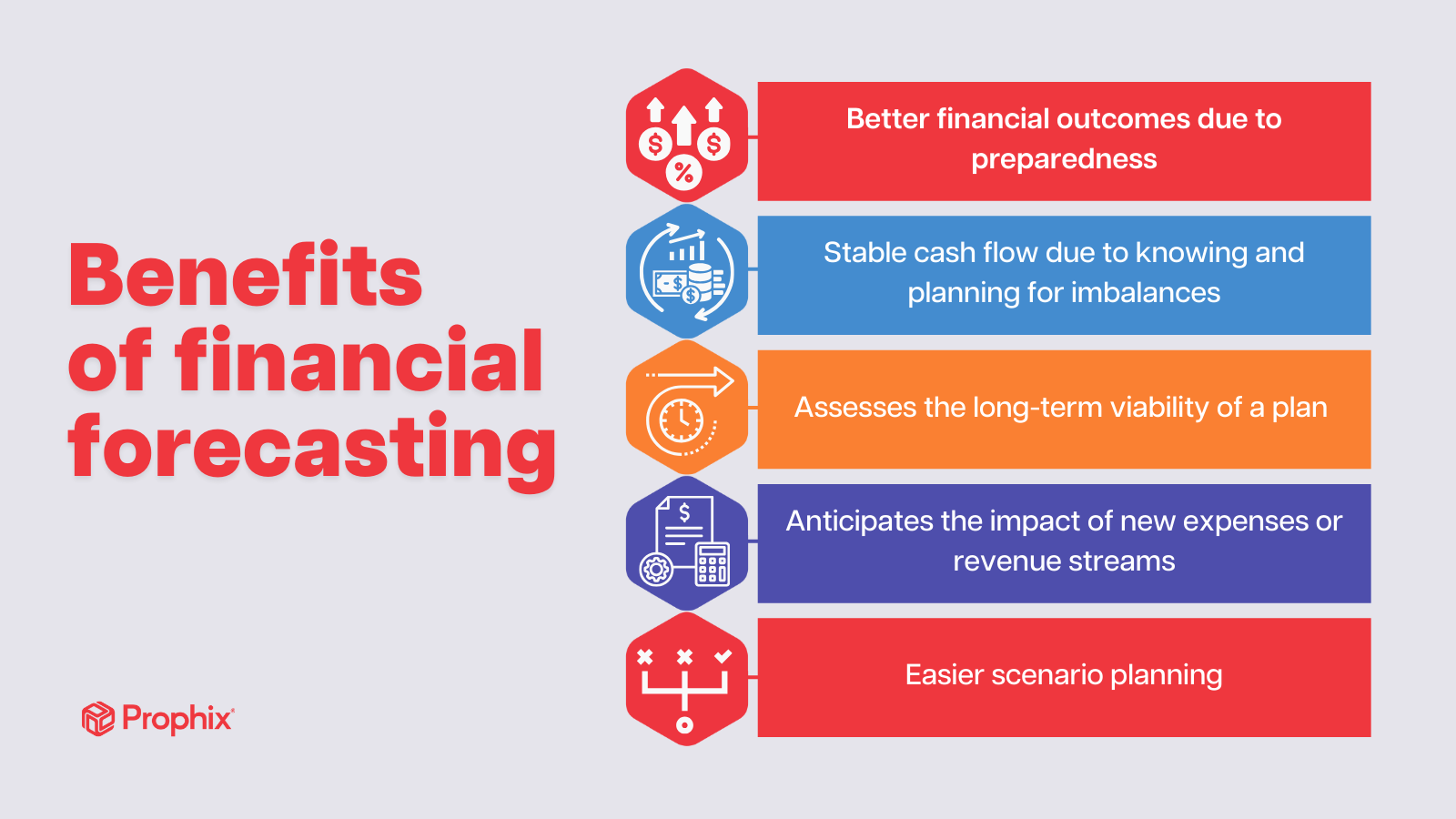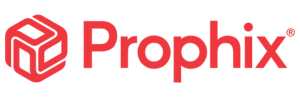Planning, budgeting, and forecasting: what's the difference?
Planning, budgeting, and forecasting are terms that get thrown around a lot in the world of corporate finance.
But what's the difference between these terms? Are they interchangeable, or are they meaningfully different?
In this article we cover the definitions and differences between planning, budgeting, and forecasting. We also cover some of the best practices for each and highlight our best software picks for businesses that want to get started with budgeting, planning, and forecasting.
- What is planning in business?
- What is budgeting in business?
- What is forecasting in business?
- What's the difference between planning, budgeting, and forecasting?
- Planning, budgeting, and forecasting best practices
- Best planning, budgeting, and forecasting software for businesses
- Frequently asked questions about planning, budgeting, and forecasting
- Conclusion: planning, budgeting, and forecasting with Prophix
What is planning in business?
Planning in business is defined as identifying a company's goals and defining the strategies to achieve them. For this reason, it's often called strategic planning.
For example, if a company's goal is to triple its ARR from $2M to $6M, then that company needs to develop a plan—identify strategies—to realize that.
Since so much of planning in business deals in finances, it's inevitable that business planning requires financial planning.
Benefits of financial planning
Financial planning in business requires clear company goals. You can't plan if you don't know what you're planning for.
There are plenty of benefits to financial planning, including, but not limited to:
- Better cash flow planning
- More intentional budgeting
- A clear growth roadmap
- Smoother fundraising
- Tighter spending and less financial waste
- Clear hiring and people planning requirements
- Enhanced transparency with financial stakeholders like board members and investors
- Preparedness for financial headwinds—creating the "there's a plan for that" mentality
The prerequisite to financial planning—clear company goals—helps direct the company's vision and focus. As David Packard of Hewlett Packard once put it, "more companies die of overeating than starvation." Financial planning helps companies focus on what's important and ignore the distractions.
Challenges of financial planning
Of course, financial planning isn't easy—if it were, more companies would do it.
Some of the challenges of financial planning include:
- Inaccurate, missing, or misleading historical financial data
- Successes in spite of mismanaged funds biasing the planning team
- Disconnected source systems that make it difficult or impossible to unite a company's financial data into a single entity
- Pushback from stakeholders, especially department leaders and individuals with different levels of risk tolerance or enthusiasm for a given strategy
- Differing visions on the direction of the business
- Striking a balance between overplanning for contingencies and not planning enough, especially when it leads to drawn-out planning processes
- Accounting for unknown, massive market disruptions like the COVID-19 pandemic or the influence of ChatGPT and OpenAI
- Results are difficult to reliably measure, as there are many confounding factors
- Similarly, lessons learned from one company—even if used as a model—might not be applicable to another, which means financial planning can sometimes feel like navigating a cave without a flashlight

Overall, the challenges of financial planning serve more to confound rather than outright prevent companies from planning. Many companies do successfully create accurate financial plans that guide the business.
What is budgeting in business?
Harvard Business School defines budgeting as "the process of preparing and overseeing a financial document that estimates income and expenses for a period."
Moreover, budgeting is how you intend to spend your money. Budgeting boils down to who gets what resources and why.
That "why" should be connected back to the financial plan.
Benefits of business budgeting
Business budgeting helps companies realize their financial plans. While business budgeting ensures the business stays around, there are plenty of good reasons to enforce a business budget, too:
- Ensures resources are available and appropriately allocated
- Shows a clear path for achieving a company's goals
- Helps prioritize important projects and de-prioritize distractions
- For companies seeking funding, budgets are requirements for securing investors
- Organizes a company's resources, which makes it easier to pivot or cut in the face of financial headwinds
- Helps budget owners meet business objectives, such as meeting sales and financial goals
- Controls a company's cash flow and maintains its financial health
- Prevents overspending and encourages debt management
In other words, business budgeting is mandatory for successful companies.

Challenges of business budgeting
Just like financial planning, business budgeting is not always easy.
- Inaccuracies in financial data can lead to misappropriations or poor estimations, causing or encouraging financial waste
- Business budgeting can be time-consuming, and it's not uncommon for the budgeting process to run up against its deadline
- Too many cooks in the kitchen can lead to an unfocused or messy budget that deviates from the company's financial plan; conversely, too few perspectives on the budget runs the risk of not budgeting for something important and necessary
- Budgets can lack transparency. In fact, a 2019 McKinsey study reports that 57% of executives felt that their organization's general and administrative spending (G&A spend) wasn't satisfactorily transparent.
- Many different budgeting types—activity-based budgeting, zero-based budgeting, value proposition budgeting, top-down budgeting, bottom-up budgeting, and so on—each have their own benefits and drawbacks. There's no universal "best method" for budgeting
- Lack of communication between departments—or from individual contributors to department leaders to the budgeting team—can leave some employees and teams feeling disgruntled or unheard when they receive the final budget
- Budgets can be difficult to enforce in practice, relying on the stewardship of the people in the position of the budget owner
But even so, despite these challenges business budgeting is necessary for the short- and long-term financial health of an organization.
Moreover, budgeting is a prerequisite to predicting how a business's future will look: a process known as forecasting.
What is forecasting in business?
A forecast is a prediction of the future given a certain scenario.
A specific forecast might look like a company forecasting its net dollar retention for the next quarter if they achieve 5% churn and upsell 20% of their accounts to the next tier.
A general forecast might look like a company forecasting its EBITDA over the next financial year if they follow the plan.
It goes without saying that the farther out a forecast goes, the less reliable it tends to be. But that doesn't mean forecasting is without value.
In fact, forecasting is an essential part of the planning and budgeting process because forecasts give companies the best data they can get on the future. They can then use that data to adjust their plans and budgets until their forecasts show that their plan is achievable.
Benefits of financial forecasting
Financial forecasting is the closest finance teams can get to seeing the future. Peeking into the crystal ball holds myriad benefits, including:
- Better financial outcomes due to better preparedness
- More stable cash flow, due to knowing and planning for cash flow imbalances
- Assess the long-term viability of a plan or initiative
- Anticipate the impact of new expenses or revenue streams on business operations
- Easier scenario planning
- Better, more realistic budgets and financial plans
With financial forecasting, it's important to keep one's expectations grounded. Forecasting is a method of shining a light on a possible future, but it is, at the end, only a guess. A data-backed guess, but still a guess.

Challenges of financial forecasting
Forecasting inherently has a level of inexactitude to it. That said, forecasting can be difficult to pull off because of a number of factors:
- Collecting, cleansing, and using past financial data can be complicated, error prone, and time consuming
- Forecasting periods might occlude important information. Zooming in or out might be necessary to get the full picture
- Forecasting is time consuming for everybody involved
- Assumptions and models might not reflect reality. Overly cautious or optimistic models run the risk of poorly influencing financial plans and budgets, leading to huge misfires that need to be corrected during the fiscal year
So the limitations and challenges of financial forecasting can't be minimized. However, that doesn't make forecasting any less powerful a tool in your arsenal. You just need to refine your assumptions and check your models.
What's the difference between planning, budgeting, and forecasting?
Planning, budgeting, and forecasting often get confused or used interchangeably, but they're not the same thing.
Planning vs. budgeting
Planning is strategic while budgeting is more tactical.
For example, a financial plan might outline a startup's path to its first $1M quarter. But the budget is what actually shows the expenses necessary to reach that $1M quarter: key hires, tool expenses, and the cost of external consultants or freelancers are just a few things that might be included.
Planning vs. forecasting
The 1983 paper "Strategic planning and forecasting fundamentals" by J. Scott Armstrong from the Wharton School of Business Planning defines the difference nicely:
"Planning provides the strategies, given certain forecasts.
Forecasting estimates the results, given the plan.
Planning relates to what the firm should do.
Forecasting relates to what will happen if the firm tries to implement a given strategy in a possible environment."
So there's a symbiotic relationship between planning and forecasting. The plan directs the forecast, and the forecast helps refine the plan.
Budgeting vs. forecasting
Budgeting is the process of allocating a company's financial resources. Forecasting is the "what if" end result of those allocations, following the company's plan.
For example, a company might budget to hire 5 more engineers, but a forecast shows they can build out the required components with 3 engineers with only one more month of development time. In this case, the budget set the parameters for the forecast, and the results of the forecast influenced the next budget.
Planning vs. budgeting vs. forecasting
So a company might plan to improve their net dollar retention by 25% next year. They budget to add 5 more heads to Customer Success to support that plan.
But the forecast shows, actually, that those 5 new Customer Success roles would have too much work, so they readjust the budget to hire 7 heads.
Or they adjust their plan by lowering their goal and increasing their revenue goal.
Planning, budgeting, and forecasting best practices
While planning, budgeting, and forecasting will look different for every team and institution, there are a few best practices we believe every finance team should follow. Let's look at a few for each.
Strategic planning best practices
- Explore distinct time horizons
Plan for the short-term, medium-term (3-5 years), and long-term. Begin with the long-range plan and work backwards, establishing milestones to hit along the way. The results of the short-term plan should roll up into the results of the medium- and long-term plans. - Measure your performance often and change the plan where needed
Stay nimble with your plans. The plan needs to be able to change and react to business and environmental circumstances. Don't fall into the trap of believing the plan can’t be changed. - Invest in execution
The best strategic plans have execution baked in. Include the budgeting process as a natural evolution of the planning process, and then implement the plan. Giving your team goals to hit—like using Google's OKR framework—helps you enact the plan in a measurable, obtainable manner.
Budgeting best practices
- Establish a single source of truth
Many teams find that their data lives in a number of disparate source systems that have little to no communication with each other. Establishing a single source of truth—like bringing all your data into a platform like Prophix—helps eliminate a lot of the doubt and mistakes that come with multiple source systems. - Involve a cross functional team
Department leaders and team managers can quickly and succinctly articulate the impact of a budget line item that they depend on or want to use. Conversations with the people doing the work contextualizes an expense's place in the budget and helps you identify what could be cut or what needs more resources. - Use automation
Automating tasks or using it to create pro forma financial statements based on the budget can be an important (and insightful) piece of the budgeting feedback process. A little bit of automation can save a lot of time and add even more value.
Forecasting best practices
- Separate predictive and causal business drivers
And then forecast them at the appropriate levels of specificity and dimensionality. You want to avoid mixing predictive and causal drivers, as this can confound your predictions. - Forecast, and then forecast again
Integrating forecasting into other areas of management will help managers make better long-term decisions. Often, managers discount the future to optimize for the short-term, incurring project debt or tech debt that needs to be paid off in the future. Having multiple forecasts on hand can circumvent that issue entirely. - Forecast as feedback into the budget and the plan
Forecasts are feedback! After finishing a forecast, you should return to the budget and the plan and tweak them, then re-forecast.This iterative forecasting process will not only help you get better at forecasting, but it'll also improve the business's performance in the long run.
Best planning, budgeting, and forecasting software for businesses
Whether you're planning, budgeting, or forecasting, having the right tool on hand is paramount to improving the speed and accuracy of your processes.
Here’s a look at three financial performance management tools that do it all.
1. Prophix

Prophix is a financial performance platform that empowers businesses with AI insights, and provides comprehensive solutions for financial consolidation, budgeting, analysis, planning, management reporting, and forecasting, turning everyday challenges into opportunities.
Best for
CFOs, directors of FP&A, FP&A analysts, and non-finance users, such as operations leaders and executives, can all get value from Prophix.
Prophix is best for mid-market and enterprise-level companies.
Features
- Automated workflows for budgeting, planning, and forecasting
- Line-item details for detailed planning and forecasting
- Customizable dashboards and reports for easy reporting your way
- Automated data integration with scheduled and real-time updates
- Full audit trail so you can always see which actions were taken
- User-based controls for robust permissions
- Built-in modeling and calculations
- Automated report distribution for enhanced transparency throughout the organization
- Self-serve ad-hoc analysis allows users to create reports
- Built-in security and user, role, and group controls
Pros
- Flexible reporting: Prophix’s Financial Performance Platform gives you the freedom to build reports that are automatically updated with changes—there’s no need to run a nightly refresh of your data or manually import new information. You don’t have to rely on pre-built templates or consultants to make changes, so you can customize your reports to fit the needs of your stakeholders. And if you need to view the information in Excel, it’s easy to export your data and modify it directly in your preferred interface, without affecting your data integrity as updates are pushed directly back into Prophix.
- Personalized data visualizations and dashboards: Prophix data visualizations and dashboards can be personalized to the unique needs of each user. With a single view of your data, you can see how various business departments, regions or lines of business are performing. There’s no need to input data into Excel-based charts, and you can use natural language artificial intelligence (AI) to provide an accurate narrative around your data to ensure all your stakeholders are on the same page. It’s also not necessary to purchase and implement a new solution to visualize your performance, as it’s all built-in to the Prophix platform.
- Robust data security and regulatory compliance: Data security and regulatory compliance are among Prophix’s top priorities. Prophix has obtained SOC 2, HIGHTRUST, and TRUSTe Enterprise Certification, in addition to several other compliance certifications. You can also assign security controls by user, role, or group. Role-based security is designed to automatically suppress pages and rows of data in a report based on preset user permissions. The Prophix platform is audited every 6 months to identify any security vulnerabilities or improvements.
- Prophix is user-friendly with responsive customer support: Prophix reviewers say that the “software is extremely user friendly and easy to implement,” and in cases where additional support is needed, the customer service team is incredibly responsive and provides timely solutions. Prophix offers a variety of additional support options, including our Customer Success Package, online, in-person, and blended learning opportunities via Prophix Academy, and access to an online-user community, so you can learn directly from your peers. Prophix also has a self-led implementation option, so you can get the platform up and running as fast as you need. In addition, as soon as your implementation is finished, you’re introduced to our Customer Success team, who are there to ensure you’re never left alone to scale your solution or solve problems.
Cons
- Prophix is not for startups or small businesses – the platform is a better fit for mid-market and enterprise companies
- Can be difficult to directly translate Excel processes to Prophix workflows
Integrations
- ERP, CRM, or accounting software like SAP, Oracle, and Microsoft Dynamics 365
- Use an API to connect to all other business systems
- Spreadsheets and flat files
Pricing
Pricing is affected by the number of users, integrations, and use cases.
2. Vena Solutions

Vena Solutions gives finance teams the familiarity and comfort of Excel but through a more modern interface. Its best selling point is that it's easy to integrate into existing spreadsheets and automates day-to-day processes to free up FP&A team time.
Best for
Vena Solutions is best for finance teams at mid-market companies who are deeply entrenched into the Microsoft ecosystem.
Features
- Excel-based interface
- Microsoft 365 compatible
- Power BI integration
- Workflows
- Pre-built templates
- Security & permissions controls
- Version control
- Audit trails
- Data drill-down
Pros
- Excel-based back-end: Vena Solution's Excel-based back-end is ideal for experienced finance users, who will find it easy to input data, create formulas, and modify templates.
- Implementation experience: Vena Solutions has experience with implementation in a number of industries, which helps finance teams understand how they can tailor Vena Solutions to their needs.
- Pre-built solutions for various industries: we were able to find on Vena Solutions's website that they have pre-built solutions for banking & credit unions, SaaS companies, insurance, manufacturing, higher education, professional sports, healthcare, not-for-profit, real estate, professional services, hotel and lodging, and construction.
Cons
- Massive learning curve: You want to be able to use the FP&A software you purchase! Spending copious amounts of time learning the new software takes away from the time you could spend on high-value tasks that drive your business forward.
- Long implementation timelines and complex set up: When implementations take months longer than expected, you run the risk of far exceeding your budget to pay for additional consulting hours, support calls, and building additional models. It's never a good feeling to delay plans because of stalled software.
- Limitations in data visualizations and analysis: Since the data in Vena is rendered in Excel, it can appear low tech. But you can fix that by implementing Power BI – an additional piece of software. However, some reviewers have identified some ongoing issues with Vena’s connection with Power BI. Other software vendors have incorporated FP&A functionality (budgeting, planning, forecasting, etc.) with powerful data visualization tools into a singular platform, without the need to implement and pay for another solution.
Integrations
Vena Solutions integrates with common on-premise source systems, cloud applications, and Excel and CSV files, like:
- SAP
- Microsoft SQL Server
- Oracle
- Sage
- NetSuite
- Sage Intacct
- Salesforce
- QuickBooks
- Microsoft Dynamics 365
Pricing
Vena Solutions has two pricing plans: Professional and Complete. While we were unable to find detailed pricing information on their website, we were able to find what's included in each plan. Professional is their most popular plan, and includes the Vena Platform, a dedicated customer success manager, standard support, and access to their customer portal.
Vena Solutions vs. Prophix
Read more about Vena vs. Prophix.
3. Planful

Planful helps businesses drive financial performance and streamline business-wide planning, budgeting, consolidations, reporting, and analytics.
Best for
Organizations of medium to large scale, with substantial FP&A teams and functional groups aiming to broaden their analytical reach beyond finance.
Features
- Consolidation
- Reporting
- Standard planning
- Scenario planning
- Drill-through and ad hoc analysis
Pros
- Flexible budget models directly connected to financial information
- Simple alterations of data with immediate updates in reports
- Thorough analysis provides a variety of KPIs, trend assessments, forecasts, and detailed views
Cons
- Not compatible with Google sheets
- Expensive and difficult to implement
- Flexibility isn’t consistent
Integrations
Planful integrates with most data sources but requires additional licensing.
Pricing
We were unable to find pricing on Planful's website.
Planful vs. Prophix
Reviewers maintain that they get more business value from Prophix vs. Planful, and that Prophix has a higher quality of ongoing product support, as well as a stronger platform roadmap.
Frequently asked questions about planning, budgeting, and forecasting
What's a budget forecast?
A budget forecast takes its inputs for the upcoming fiscal period from the budget. It is, in other words, a forecast based on a budget.
Are budgeting and forecasting part of FP&A?
Yes, budgeting and forecasting are both part of FP&A. Although FP&A stands for "financial planning and analysis," budgeting and forecasting are understood to be included under the "financial planning" umbrella.
What's the key difference between a plan vs. a budget vs. a forecast?
The key difference between a plan vs. a budget vs. a forecast is that a plan is high-level and focused on goals, a budget determines a company's resource allocations according to the plan, and a forecast is a potential future state based on the resource allocations in the budget.
Conclusion: Planning, budgeting, and forecasting with Prophix
Now you know the difference between planning, budgeting, and forecasting.
Planning, often called strategic planning, is the process of outlining a company's goals and choosing a strategy to achieve those goals.
Budgeting is the process of allocating a company's financial resources as directed by its plan.
Forecasting is the process of checking the expected result of the budget at a point in the future. The results of a forecast often lead to tweaks or changes in the plan or the budget until all three (the plan, the budget, and the forecast) tell the same story.
Ready to see what you can do with Prophix? Watch this short demo video!
